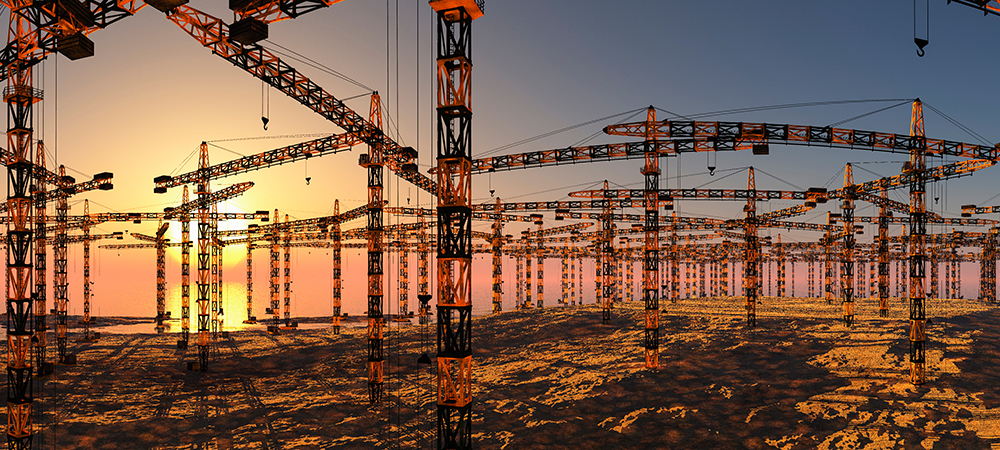The simplest way for regional construction organisations to get started with AI is by focusing on how data is organised, managed, used, unused and those organisations that master data management and use digital twins can unlock the potential of AI, says Julien Moutte at Bentley Systems.
The Middle East is buzzing with billion-dollar megaprojects. Out of all nine ongoing megaprojects named by 1build, International Construction Magazine, and Construction Review to cost $100 billion or more, four were being built in the Arab Gulf Region.
From rethinking urban development with NEOM in Saudia Arabia to reshaping how goods and people are transported via the Gulf Cooperation Council, GCC rail programme, the sheer number and scope of megaprojects highlight the many opportunities to advance infrastructure across the region.
However, much like Europe, North America, and Asia Pacific, which are also experiencing a surge in infrastructure development, projects in the Middle East face similar engineering and skilled labour constraints, delivery delays and overruns, supply chain challenges, and the growing need to meet resiliency and sustainability requirements.
How can infrastructure engineers, construction contractors, and owner-operators across the region address these challenges and improve project delivery and asset performance?
Over the last year, there has been a lot of discussion about using AI-powered applications and solutions to improve project efficiency, organisational effectiveness, and infrastructure outcomes. Leveraging AI, machine learning, and other intelligent applications presents immense potential for addressing issues across the infrastructure life cycle.
Unfortunately, data is the foundation for AI-powered anything and the infrastructure sector has a large data management hurdle it must clear before the promise of AI can be realised.
Better data
For decades, the infrastructure project lifecycle was linear. Planning, design, procurement, construction, and operations had distinct phases with individual stakeholders, requirements, and discrete hand-offs. Each phase typically used different technologies and processes.
This approach created information silos and data loss, resulting in design rework and errors, project delays, and increased costs and risks.
As infrastructure projects and their respective phases have become more interconnected, there is a real need for bringing engineering, information, and operational technology systems and data together.
But the reality is that an abundance of valuable data from these technology systems is trapped in files, models, drawings, and even paper. Unlocking this data is critical to better decision-making across the infrastructure project lifecycle as well as for using AI-powered solutions.
Instead of generating critical project and asset data in disparate systems, infrastructure engineers, construction contractors, and owner-operators should start producing data layers with open platforms that generate digital twins.

Digital twins
Over the last few years, digital twins have become a hot topic across every sector. What was once considered futuristic eye candy has evolved into a powerful and valuable way to combine and use data from disparate sources and multiple disciplines into a holistic, dynamic representation of infrastructure projects and assets.
In addition to offering a structured way that brings siloed data together, digital twins can unlock data from existing design files, essentially lighting up dark data.
When digital twin capabilities persist across the infrastructure project life cycle, they create workflows that enable engineers to seamlessly conduct design reviews, structural analysis, and calculate carbon footprints.
Digital twin workflows can help construction companies improve the accuracy of quantity take-offs, project scheduling, and more. Just like their value in bringing data together, infrastructure digital twins can connect processes between the different life cycle stages of a project and asset.
As data layers are combined and processes are connected, their collective value is compounded exponentially. It is this value that provides the foundation for quickly and easily applying AI techniques and technologies to drive actionable insights and infrastructure better outcomes.
Generative AI for infrastructure
Certain AI techniques and technologies are not new to the infrastructure sector. For example, owner-operators have already started using computer vision AI techniques to quickly find, analyse, and detect spalling, corrosion, and other defects that compromise the integrity of bridges, dams, rail networks, and more.
However, what is new and what presents significant value to infrastructure organisations across the project lifecycle is generative AI.
In a sector challenged by resource constraints, delays, cost overruns, and evolving sustainability requirements, engineering and construction applications with generative AI capabilities have the potential to automate tasks, streamline workflows, improve project delivery, and ensure asset performance.
Generative AI technologies could give engineers the ability to collaborate with AI agents to generate and optimise infrastructure design. It could compare designs to earlier ones and learn from an engineer’s choices. Generative AI could help engineers and construction managers use more sustainable building materials to reduce an asset’s carbon footprint or calculate an infrastructure project’s embodied carbon from start to finish.
Generative AI will give infrastructure engineers, construction contractors, and owner-operators the ability to experiment with real-life developments in a simulated environment, enabling more predictive activities and outcomes that will mitigate future challenges and risks. And that potential is too valuable to ignore.
Can AI address infrastructure project challenges in the Middle East region and beyond? Yes.
However, there is still foundational work that needs to be done. The simplest and fastest way for infrastructure organisations to get started with AI is by focusing on how data is organised, managed, used, and unused. Organisations that master data management and use digital twins will be best positioned to unlock the potential of AI.



